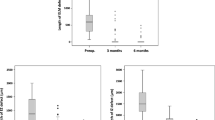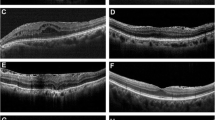Abstract
Objective
To analyze the foveal surface using binary image analysis after spectral-domain optical coherence tomography (SD-OCT) following 23-gauge macular surgery in epiretinal membranes (ERM) using either air tamponade (AIR) or balanced salt solution (BSS).
Methods
One hundred twenty-four eyes (124 patients) with ERM that had undergone membrane peeling with installation of air or BSS were analyzed retrospectively. Ophthalmic examination was performed at baseline and 3 months. Outcome measures: The foveal area and surface symmetry, area matched thickness, area matched contour, and best-corrected visual acuity (BCVA). The OCT images were analyzed after binary conversion with ImageJ software.
Results
Eighty eyes (80 patients) of 124 screened patients were included (AIR group: 39 patients, BSS group: 41 patients). Median follow-up time was 14 weeks (range, 9–19 weeks). Three months after surgery, the median horizontal area decreased significantly in both groups (p < 0.0001). At follow-up, the foveal surface symmetry values for the BSS group (median, 22.73 μm, range, 0–153) were significantly lower than for the AIR group (median, 23.95 μm, range, 0–160.43) (p < 0.0001). The area-matched thickness increased significantly in both groups (p < 0.001). The AIR group showed a significant increase of the area matched contour for the nasal located measurement-areas N1 (p < 0.0003), N2 (p < 0.0079), N3 (p < 0.007). The BSS group showed a significant increase of the area-matched contour for the measurement areas N1 (p < 0.019), N2 (p < 0.0014), and N4 (p < 0.022). After surgery, median BCVA for both groups increased significantly to 0.3 logMAR.
Conclusions
The analysis of early contour changes after ERM surgery was technically possible. Long-term data have to be looked at before the clinical impact of this methodology can be estimated. Although there were no big differences between both groups (AIR vs. BSS), this could change within a longer and more representative follow-up.





Similar content being viewed by others
References
Ting FS, Kwok AK (2005) Treatment of epiretinal membrane: an update. Hong Kong Med J 11:496–502
Lim JW, An TS (2011) Results at 12 months after surgery for epiretinal membrane: the foveal configurations by optical coherence tomography. Acta Ophthalmol (Copenh) 89:e661–662
Wong JG, Sachdev N, Beaumont PE, Chang AA (2005) Visual outcomes following vitrectomy and peeling of epiretinal membrane. Clinical Experimental Ophthalmology 33:373–378
Thompson JT (2011) Advantages and limitations of small gauge vitrectomy. Survey Ophthalmology 56:162–172
Eckardt C (2005) Transconjunctival sutureless 23-gauge vitrectomy. Retina 25:208–211
Clark A, Balducci N, Pichi F, Veronese C, Morara M, Torrazza C, Ciardella AP (2012) Swelling of the arcuate nerve fiber layer after internal limiting membrane peeling. Retina 32:1608–1613
Sigler EJ, Randolph JC, Charles S (2013) Delayed onset inner nuclear layer cystic changes following internal limiting membrane removal for epimacular membrane. Graefes Arch Clin Exp Ophthalmol 251:1679–1685
Inoue M, Arakawa A, Yamane S, Kadonosono K (2012) Long-term outcome of preoperative disrupted inner/outer segment junctions assessed using spectral-domain optical coherence tomography in patients with idiopathic epiretinal membrane. Ophthalmologica 228:222–228
Krebs I, Smretschnig E, Moussa S, Brannath W, Womastek I, Binder S (2011) Quality and reproducibility of retinal thickness measurements in two spectral-domain optical coherence tomography machines. Investigative Ophthalmology Visual Sci 52:6925–6933
Rasband WS (1997–2012) Image J
Treumer F, Wacker N, Junge O, Hedderich J, Roider J, Hillenkamp J (2011) Foveal structure and thickness of retinal layers long-term after surgical peeling of idiopathic epiretinal membrane. Investigative Ophthalmology Visual Sci 52:744–750
Niwa T, Terasaki H, Kondo M, Piao CH, Suzuki T, Miyake Y (2003) Function and morphology of macula before and after removal of idiopathic epiretinal membrane. Investigative Ophthalmology Visual Sci 44:1652–1656
Suh MH, Seo JM, Park KH, Yu HG (2009) Associations between macular findings by optical coherence tomography and visual outcomes after epiretinal membrane removal. Am J Ophthalmol 147(473–480):e473
Ivanovska-Adjievska B, Boskurt S, Semiz F, Yuzer H, Dimovska-Jordanova V (2012) Treatment of idiopathic macular hole with silicone oil tamponade. Clin Ophthalmol 6:1449–1454
Cekic O, Cakir M, Alagoz N, Yilmaz OF (2011) Retinal thickness change in relation to visual acuity improvement after 23-gauge vitrectomy for idiopathic epimacular membrane. Eye 25:180–184
Massin P, Allouch C, Haouchine B, Metge F, Paques M, Tangui L, Erginay A, Gaudric A (2000) Optical coherence tomography of idiopathic macular epiretinal membranes before and after surgery. Am J Ophthalmol 130:732–739
Almony A, Nudleman E, Shah GK, Blinder KJ, Eliott DB, Mittra RA, Tewari A (2012) Techniques, rationale, and outcomes of internal limiting membrane peeling. Retina 32:877–891
Pesin SR, Olk RJ, Grand MG, Boniuk I, Arribas NP, Thomas MA, Williams DF, Burgess D (1991) Vitrectomy for premacular fibroplasia. Prognostic factors, long-term follow-up, and time course of visual improvement. Ophthalmology 98:1109–1114
Rice TA, De Bustros S, Michels RG, Thompson JT, Debanne SM, Rowland DY (1986) Prognostic factors in vitrectomy for epiretinal membranes of the macula. Ophthalmology 93:602–610
Itoh Y, Inoue M, Rii T, Hiraoka T, Hirakata A (2012) Correlation between length of foveal cone outer segment tips line defect and visual acuity after macular hole closure. Ophthalmology 119:1438–1446
Chhablani JK, Kim JS, Cheng L, Kozak I, Freeman W (2012) External limiting membrane as a predictor of visual improvement in diabetic macular edema after pars plana vitrectomy. Graefes Arch Clin Exp Ophthalmol 250:1415–1420
Conflict of interest
All authors disclose no actual or potential conflicts of interest.
Author information
Authors and Affiliations
Corresponding author
Rights and permissions
About this article
Cite this article
Leitritz, M.A., Ziemssen, F., Voykov, B. et al. Early postoperative changes of the foveal surface in epiretinal membranes: comparison of 23-gauge macular surgery with air vs. balanced salt solution. Graefes Arch Clin Exp Ophthalmol 252, 1213–1219 (2014). https://doi.org/10.1007/s00417-014-2573-y
Received:
Revised:
Accepted:
Published:
Issue Date:
DOI: https://doi.org/10.1007/s00417-014-2573-y




